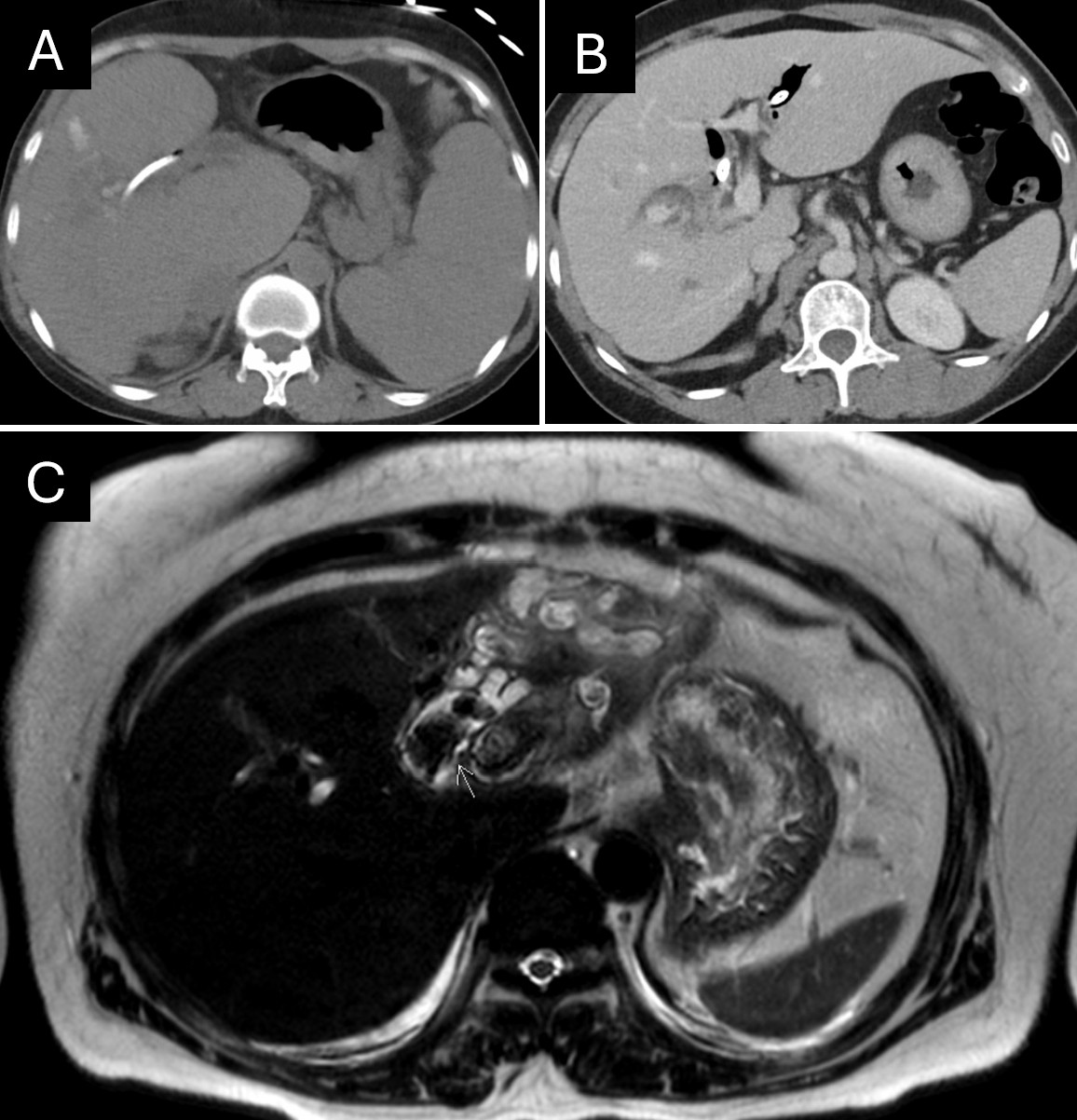Monday Poster Session
Category: Biliary/Pancreas
P2279 - Leave No Stone Unturned: Recurrent Pyogenic Cholangitis in the West
Monday, October 27, 2025
10:30 AM - 4:00 PM PDT
Location: Exhibit Hall

Alexandra MacBride, MD
University of Nebraska Medical Center
Omaha, NE
Presenting Author(s)
Alexandra MacBride, MD1, Shaheed Merani, MD, PhD2, Stacie Williams, RN, BSN3, Natapat Chaisidhivej, MD1, Bilal Niazi, MD1, Fedja A. Rochling, MBBCh, MBA4
1University of Nebraska Medical Center, Omaha, NE; 2Unviersity of Nebraska Medical Center, Omaha, NE; 3Nebraska Medicine, Omaha, NE; 4UNMC, Omaha, NE
Introduction: Recurrent pyogenic cholangitis (RPC) is a chronic hepatobiliary condition characterized by recurrent biliary tract infections, intrahepatic pigmented stone formation, and progressive biliary obstruction. Though endemic to Southeast Asia, increased global travel and immigration have brought RPC into Western clinical settings. It can lead to abscesses, strictures, secondary biliary cirrhosis, and rarely, cholangiocarcinoma. RPC pathogenesis is multifactorial, relating to transient portal bacteremia and altered biliary drainage. This case series highlights the presentation, complexity, and treatment considerations of RPC in a Western tertiary care center.
Case Description/
Methods: Case 1: A 43-year-old Burmese female with RPC, secondary biliary cirrhosis, and liver abscesses presented with cholangitis. Over four years, she had four hospitalizations for septic shock requiring multiple ERCPs with stent placements and CT-guided drain placement (Fig A). Despite a low MELD 3.0 of 8, transplant evaluation was pursued due to recurrent infections. She remains unlisted due to a lack of a care partner.
Case 2: A 42-year-old Burmese female with RPC and chronic hepatic schistosomiasis was admitted with cholangitis. ERCP with partial stone clearance and a percutaneous internal-external biliary drain was performed (Fig B). Post-procedure, she developed septic shock from polymicrobial bacteremia. Management has included multiple biliary drainages and a planned cholecystectomy prior to metallic stent placement to facilitate further ERCPs.
Case 3: A 54-year-old Thai female with a history of cholecystectomy and RPC presented with cholangitis. MRCP revealed an atrophic left hepatic lobe with dilated left intrahepatic bile ducts (Fig C). ERCP showed left intrahepatic duct dilation with a filling defect; lithotripsy and stone extraction were performed. She underwent left lateral hepatic segmentectomy, revealing intrahepatic cholangiocarcinoma.
Discussion: RPC is a rare but severe condition commonly seen in Southeast Asians. These cases emphasize its diagnostic and therapeutic complexity and the need for individualized, multidisciplinary care. Addressing social barriers is also essential for equitable care and access to advanced therapies, including liver resection and transplantation.

Figure: Fig A: CT-guided drain placement into a lobulated intrahepatic abscess within hepatic segment 5. Fig B: Extensive intrahepatic ductal dilation with pneumobilia with internal/external biliary duct drain in place. Fig C: RPC of the left hepatic lobe with markedly dilated intrahepatic ducts with multiple large stones and filling defects with cholestasis, pneumobilia, and diffuse enhancement of the left hepatic lobe; found to be cholangiocarcinoma on pathology.
Disclosures:
Alexandra MacBride indicated no relevant financial relationships.
Shaheed Merani: Bridge to Life – Grant/Research Support. CareDx – Grant/Research Support. Paragonix – Grant/Research Support. Transmedics – Grant/Research Support.
Stacie Williams indicated no relevant financial relationships.
Natapat Chaisidhivej indicated no relevant financial relationships.
Bilal Niazi indicated no relevant financial relationships.
Fedja Rochling indicated no relevant financial relationships.
Alexandra MacBride, MD1, Shaheed Merani, MD, PhD2, Stacie Williams, RN, BSN3, Natapat Chaisidhivej, MD1, Bilal Niazi, MD1, Fedja A. Rochling, MBBCh, MBA4. P2279 - Leave No Stone Unturned: Recurrent Pyogenic Cholangitis in the West, ACG 2025 Annual Scientific Meeting Abstracts. Phoenix, AZ: American College of Gastroenterology.
1University of Nebraska Medical Center, Omaha, NE; 2Unviersity of Nebraska Medical Center, Omaha, NE; 3Nebraska Medicine, Omaha, NE; 4UNMC, Omaha, NE
Introduction: Recurrent pyogenic cholangitis (RPC) is a chronic hepatobiliary condition characterized by recurrent biliary tract infections, intrahepatic pigmented stone formation, and progressive biliary obstruction. Though endemic to Southeast Asia, increased global travel and immigration have brought RPC into Western clinical settings. It can lead to abscesses, strictures, secondary biliary cirrhosis, and rarely, cholangiocarcinoma. RPC pathogenesis is multifactorial, relating to transient portal bacteremia and altered biliary drainage. This case series highlights the presentation, complexity, and treatment considerations of RPC in a Western tertiary care center.
Case Description/
Methods: Case 1: A 43-year-old Burmese female with RPC, secondary biliary cirrhosis, and liver abscesses presented with cholangitis. Over four years, she had four hospitalizations for septic shock requiring multiple ERCPs with stent placements and CT-guided drain placement (Fig A). Despite a low MELD 3.0 of 8, transplant evaluation was pursued due to recurrent infections. She remains unlisted due to a lack of a care partner.
Case 2: A 42-year-old Burmese female with RPC and chronic hepatic schistosomiasis was admitted with cholangitis. ERCP with partial stone clearance and a percutaneous internal-external biliary drain was performed (Fig B). Post-procedure, she developed septic shock from polymicrobial bacteremia. Management has included multiple biliary drainages and a planned cholecystectomy prior to metallic stent placement to facilitate further ERCPs.
Case 3: A 54-year-old Thai female with a history of cholecystectomy and RPC presented with cholangitis. MRCP revealed an atrophic left hepatic lobe with dilated left intrahepatic bile ducts (Fig C). ERCP showed left intrahepatic duct dilation with a filling defect; lithotripsy and stone extraction were performed. She underwent left lateral hepatic segmentectomy, revealing intrahepatic cholangiocarcinoma.
Discussion: RPC is a rare but severe condition commonly seen in Southeast Asians. These cases emphasize its diagnostic and therapeutic complexity and the need for individualized, multidisciplinary care. Addressing social barriers is also essential for equitable care and access to advanced therapies, including liver resection and transplantation.

Figure: Fig A: CT-guided drain placement into a lobulated intrahepatic abscess within hepatic segment 5. Fig B: Extensive intrahepatic ductal dilation with pneumobilia with internal/external biliary duct drain in place. Fig C: RPC of the left hepatic lobe with markedly dilated intrahepatic ducts with multiple large stones and filling defects with cholestasis, pneumobilia, and diffuse enhancement of the left hepatic lobe; found to be cholangiocarcinoma on pathology.
Disclosures:
Alexandra MacBride indicated no relevant financial relationships.
Shaheed Merani: Bridge to Life – Grant/Research Support. CareDx – Grant/Research Support. Paragonix – Grant/Research Support. Transmedics – Grant/Research Support.
Stacie Williams indicated no relevant financial relationships.
Natapat Chaisidhivej indicated no relevant financial relationships.
Bilal Niazi indicated no relevant financial relationships.
Fedja Rochling indicated no relevant financial relationships.
Alexandra MacBride, MD1, Shaheed Merani, MD, PhD2, Stacie Williams, RN, BSN3, Natapat Chaisidhivej, MD1, Bilal Niazi, MD1, Fedja A. Rochling, MBBCh, MBA4. P2279 - Leave No Stone Unturned: Recurrent Pyogenic Cholangitis in the West, ACG 2025 Annual Scientific Meeting Abstracts. Phoenix, AZ: American College of Gastroenterology.
